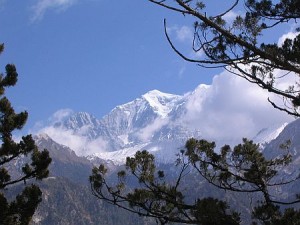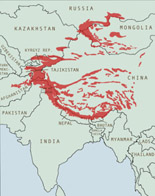
A surprise awaited researchers when they found a common leopard on photos taken by their remote trail camera in Annapurna region, Nepal. Traditionally snow leopard habitat it was always thought by researchers that the habitat of snow leopards and common leopards didn’t overlap.(SLC/NTNC). But now that we know common leopards do go as high as 3000m, what does it mean for snow leopards?
Countries like India, Bhutan, Nepal and China have both snow leopards (Panthera Uncia) and common leopards (Panthera Pardus). Snow leopard and common leopard, although very different in shape and colour, are similar in size and studies have shown they have similar food habits, liking wild animals like musk deer and Himalayan tahr. They also prey on the same domestic animals like yaks, sheep and goats.
Until recently researchers thought snow leopards and common leopards would not share the same habitat. Snow leopards occur at a significantly higher altitude than common leopards as they are a cold-adapted species of open rocky mountain habitats. Common leopards on the other hand prefer lower altitudes and have a preference for forest or woodland.
But now we know that their habitat does in fact overlap. How do we know this? A surprise awaited the researchers at the Snow Leopard Conservancy when they found evidence that common leopards do in fact go as high up the mountains .as the lower reaches that snow leopards visit.
As part of a study the SLC used remote camera traps set out by herders and school students in the Mustang region of the Annapurna Conservation Area in central Nepal. When the photos were downloaded it was a shock to see in a few of them a very healthy common leopard was walking across the rocky outcrops of traditional snow leopard habitat at an altitude of over 3000m up the mountains.

Traditional snow leopard habitat, the Annapurna region of Nepal. Researchers have found common leopard goes as high as 3000m. Photo Sibylle Noras.
The SLC reports that a village chief from the region named Ghirmi is aware that common leopard can be found in the area and that their domestic livestock is a target.
“Yak calves are the target,” Ghirmi says, “sometimes it is the snow leopard that kills the animals while other times it may be the common leopard. But villagers always blame the snow leopard because they do not believe common leopards go up to 3000m.
“Thanks to Snow Leopard Conservancy we now know that common leopards also visit our mountains!” Ghirmi says. “I showed villagers the leopard photos,” he explains. “It caught sceptics by surprise.”
As climate change brings the upper limits of forests higher due to temperature increases and less snow, it may be that common leopards will go higher in search of prey and thus overlap even more with snow leopards. Does this mean snow leopards will lose more habitats? What impact would common leopards have on snow leopards? Would aggression occur between the two and if so how would the snow leopard, known to be the lesser aggressive cat, fare? Would there be enough prey for both cats to survive in this area? More study needs to be done to answer these questions, protect herders’ livestock and ensure the future of both of these magnificent leopards.




Comments on this entry are closed.